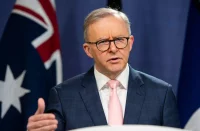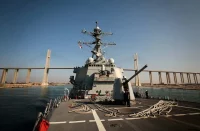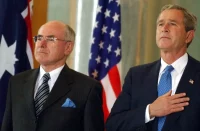In late 2011 Frederic C. Hof, one of the State Department`s point man on Syrian policy, equaled the Assad regime to ‘a dead man walking’. At the end of December, 2011, Hof joined a special secret committee set up by the Obama administration to discuss possible scenarios of Syrian intervention. The Foreign Policy magazine said that an ‘unusually small’ group of officials from the Pentagon, the State Department, the Department of the Treasury and other bodies was headed by Steven Simon, National Security Council senior director for the Middle East and North Africa. This group operates beyond a traditional format of cooperation between American governmental institutions.
On December 20, 2011, the Henry Jackson Society, an influential think- tank headquartered in London, released a plan headlined Intervention in Syria? An Assessment of Legality, Logistics and Hazards prepared by Michael Weiss, Communications and Acting Research Director of The Henry Jackson Society. Mr. Weiss begins by outlining preconditions for the intervention. He says that any charges against the Syrian government could be used as a pretext for intervention. The plan suggests that multilateral intervention in Syria should begin with air strikes by Anglo-French-American-Turkish forces to establish a ‘safe area’- or a protected zone, similar to the one they had in Libya`s Benghazi, which would be a stronghold of the Syrian Liberation Army.
Turkey is well-placed as a command central for coordinating personnel and aircraft needed for preemptive strikes on the regime’s air-defense systems. In late November, 2011, the Turkish government first publicly announced the possibility of a military intervention in Syria. Turkish Foreign Minister Ahmet Davutoglu described the measure as ‘forced but quite real’. The US State Secretary Hillary Clinton confirmed the likelihood of the intervention as she attended a meeting of the Friends of Syria Group in Paris on April 19. Any provocation staged by the US or Ankara could be used as a pretext for a NATO-led invasion in Syria.
On May 2-12 the North East Multinational Corps held the Crystal Eagle-2012 exercises in Denmark, involving some 1,500 troops from 15 countries (Austria, the Czech Republic, Croatia, Denmark, Estonia, France, Germany, Lithuania, Italy, Poland, Romania, Slovakia, Slovenia, Spain and the U.S). A scenario was settled in a fictitious Auriga. The troops had to prevent a local conflict from turning into a civil war. The UNSC decided to launch a military operation comprising the North East Multinational Corps to bring stability to the region. Obviously, a fictitious Auriga was hiding the real name – Syria. Taking into consideration the recent statements made by Davutoglu and Clinton, the exercises in Denmark prove that NATO has been already preparing for a military solution to the Syrian issue. Apart from this, on June 1-16 Lithuania, Latvia, Poland, Estonia and Germany have been holding the large-scale Baltops-2012 naval drills aimed to practice the use of multinational forces in settling a crisis. Since Syria has ports in the Mediterranean, it is clear that NATO has been focusing on both land and naval scenarios of the Syrian intervention.
The Turkish government led by Recep Erdogan dreams of building a new Ottoman Empire and thus is actively involved in the implementation of the US ‘Greater Middle East’ project. Turkey`s former Industry and Trade Minister Bülent Esinoğlu, the author of the ‘Flooded by the West’ book, Erdogan is a co-chairman of the “Greater Middle East” project and is ready to do everything possible to ensure the separation of Syria in three parts as required by Washington. But Turkey seems to be unaware of digging its own grave: the current situation is actually about separating large Islamic states into smaller ones so that the weakening United States could keep on controlling this oil-rich region.
The U.S. once actively supported Saddam Hussein`s plans to attack Kuwait and later accused the latter of initiating aggression and staged Operation Desert Storm, which was followed by another intervention in Iraq in 2003. It resulted in Hussein`s execution. Now Erdogan seems to be following in his late counterpart`s footsteps: after Turkey invades Syria the international community could blame the Erdogan Cabinet for initiating aggression, also mentioning the bombing of suspected hideouts of the Kurdish rebel groups in northern Iraq. Although Turkey is a NATO member and also remains a strategic partner for the US in the Middle East, it had not yet received Washington`s support in fighting the Kurdish separatism and terrorism. On March 21 the U.S. Commission on International Religious Freedom unveiled its annual report, urging to put Turkey on the list of countries offending religious freedom. On the same day the Kurdish leader Massoud Barzani declared the establishment of the independent Kurdish state (which was, however, postponed). The Kurds refer to the autonomy in northern Iraq as ‘Southern Kurdistan’, while there is also ‘Western Kurdistan’ (Syria), Eastern Kurdistan (Iran) and Northern Kurdistan (Turkey). In other words, the Arab Spring uprising has caused the worsening of the Kurdish issue which had remained unsettled since WW I.
 Plans to establish the state of Kurdistan were first unveiled long time ago, but their actual implementation could hardly have been real without the US Iraqi campaign of 2003. There is much evidence to conclude that the US planned to weaken Turkey`s influence in the region by establishing a new state of Kurdistan on its territory. In June of 2006 the U.S. military`s Armed Forces Journal published Lieutenant-Colonel Ralph Peters’ map of a redrawn Middle East. This map was used ruing training courses at the NATO Defense College in Rome and was unveiled to the public there on September 15, 2006.
Plans to establish the state of Kurdistan were first unveiled long time ago, but their actual implementation could hardly have been real without the US Iraqi campaign of 2003. There is much evidence to conclude that the US planned to weaken Turkey`s influence in the region by establishing a new state of Kurdistan on its territory. In June of 2006 the U.S. military`s Armed Forces Journal published Lieutenant-Colonel Ralph Peters’ map of a redrawn Middle East. This map was used ruing training courses at the NATO Defense College in Rome and was unveiled to the public there on September 15, 2006.
Mr. Peters, who is still an influential person in the Pentagon, a free Kurdish state must unite the territories of Iraq, Syria, Turkey and Iran, which obviously suggests splitting these countries into smaller parts. The territory in question is rich in oil and other resources. So the new state would be grateful to the US government for the support and would share its resources, like it was in Iraq after the 2003 invasion, and South Sudan which is currently involved in active cooperation with the U.S.
It is evident that the Arab Spring uprising has sparked another stage of the re-division of the Middle East and North Africa lands, the process which involves both western and Arab states. But it is not at all evident that in these circumstances Turkey will manage to protect its borders. When the Syrian intervention begins, Turkey will find itself in a very risky situation. Instead of trying to keep status quo now when the Middle East is living through very tough times, the Erdogan government is getting its nation involved in a very risky venture. It is hard to argue with Ronald Reagan who said: “The Kurds are like a match America could light whenever it decides to”.
Source: Strategic Culture Foundation














Pingback: Turkey: Taking a Risk With the U.S. In Syria « Therearenosunglasses’s Weblog